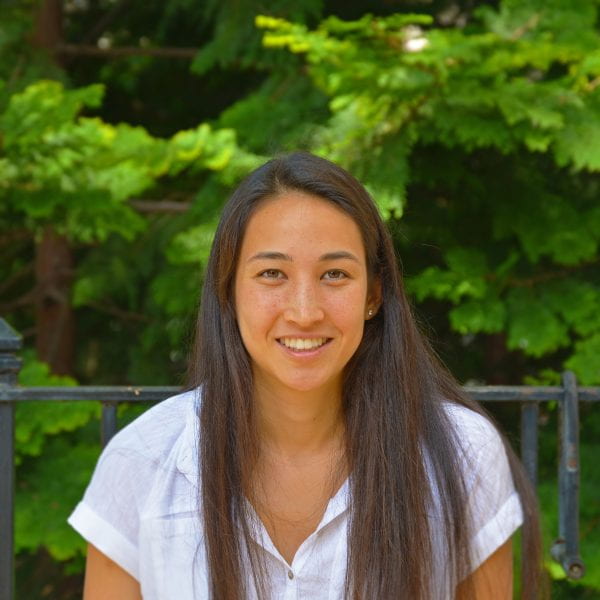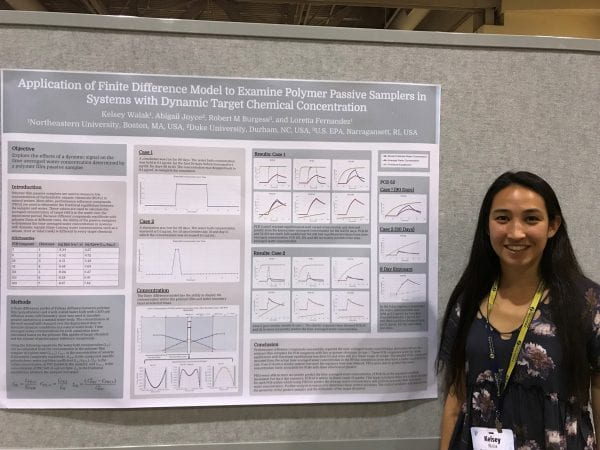Kelsey Walak is a chemical engineering student minoring in mathematics who recently completed her first co-op as a ROUTES Scholar in Fall 2019. Kelsey became a ROUTES Scholar to learn more about conducting environmental research with Dr. Loretta Fernandez. In her role as a Research Technician from July – December 2019, Kelsey was responsible for creating a model in MATLAB that simulates the uptake and release of contaminates into a passive sampler, specifically looking at PCB congeners partitioning into a polyethylene strip.

Dr. Loretta’s lab focuses on the use of a passive sampler to monitor contaminants in the environment. A common sampler Kelsey found herself using were sheets of polyethylene plastic that can be purchased at any local hardware store. These sheets of polyethylene are placed within water or sediment in a natural water body for up to around three months to collect contaminants in the environment. “Passive samplers are cheap, low maintenance, versatile samplers and a great tool to see if remediation methods are effective in reducing contamination at these sites by measuring the water concentration before and after remediation,” says Kelsey. “Passive samplers are excellent devices to test water contamination to inform the public about potential health risks.” Hydrophobic contaminants will accumulate in the polyethylene sheet at concentrations much higher than the surrounding environment and once taken back to the lab the accumulated contaminants can be extracted and analyzed. The extracts are quantified using a gas chromatographer tandem mass spectrometer to back-calculate the water concentration in the environment.
During her co-op, Kelsey created a mathematical model using MATLAB that simulates a piece of polyethylene in the environment with a dynamic water concentration. She used it to explore whether passive samplers actually report a time-averaged water concentration. Using this model researchers can gain knowledge about specific field situations for their contaminates of interest. PCBs, also known as polychlorinated biphenyls, are manmade chemicals and some of the most stable organic compounds known. According to the EPA, PCB congeners are defined as “any single, unique well-defined chemical compound in the PCB category.”[1] It was found that in the field, passive samplers may not report the time-weighted average water concentration because different compounds diffuse in and out of the sampler at different rates when the environment has varying water concentrations. For example, samplers may only report the final water concentration for small compounds (such as PCB 3), missing out on potentially vital data.
The inspiration for Kelsey’s research was a study in New Bedford Harbor on the uptake and release of PCB congeners from a passive sampler. When asked how this study related to her mathematical model, she said:
“There was a little bit of interesting data (from the study) that did not follow the expected exponential uptake and it was predicted that dredging happening downstream causing a water concentration spike. The spike affected the uptake of some contaminants and my model was designed to analyze that further. A computer model makes it easier to run a bunch of different trials and generate a significant amount of data. It is easier and quicker than actually going out into the field and deploying and retrieving samplers. It also eliminates the cost of supplies.”
This model does not provide data directly for the general public but can be applied in future case studies to give event-specific advice. It will also help make passive sampler research more accurate as scientists should be wary about the deployment times and conditions of their samplers. Passive samplers have been used to investigate superfund sites and other hazardous waste sites, and Kelsey’s model will help further the understanding of using passive samplers to examine contaminates in natural water bodies.
Kelsey presented her mathematical model at the 40th Society of Toxicology and Chemistry Annual Conference (SETAC) in Toronto, Canada last November. Her poster titled “Application of Finite Difference Model to Examine Polymer Passive Samplers in Systems with Dynamic Chemical Concentration” displayed research in collaboration between Northeastern University, Duke University, and the EPA. Following her graduation from Northeastern in May 2021, Kelsey hopes to attend graduate school to pursue a master’s degree. We wish her the best in her pursuits and expect great things from her moving forward.

[1] https://www.epa.gov/pcbs/table-polychlorinated-biphenyl-pcb-congeners
